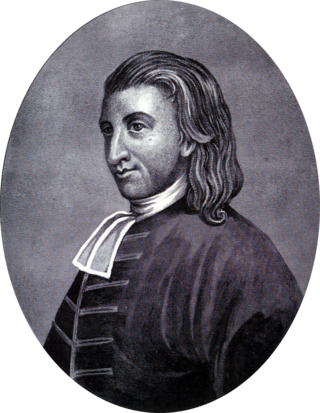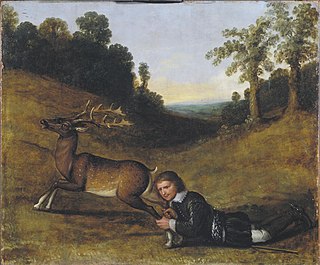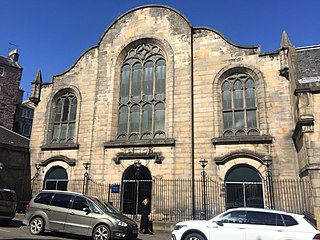
Ebenezer Erskine was a Scottish minister whose actions led to the establishment of the Secession Church.

Thomas Boston was a Scottish Presbyterian church leader, theologian and philosopher. Boston was successively schoolmaster at Glencairn, and minister of Simprin in Berwickshire, and Ettrick in Selkirkshire. In addition to his best-known work, The Fourfold State, one of the religious classics of Scotland, he wrote an original little book, The Crook in the Lot, and a learned treatise on the Hebrew points. He also took a leading part in the Courts of the Church in what was known as the "Marrow Controversy," regarding the merits of an English work, The Marrow of Modern Divinity, which he defended against the attacks of the "Moderate" party in the Church. Boston, if unduly introspective, was a man of singular piety and amiability. His autobiography is an interesting record of Scottish life, full of sincerity and tenderness, and not devoid of humorous touches, intentional and otherwise.

Robert Wodrow was a Scottish minister and historian, known as a chronicler and defender of the Covenanters. Robert Wodrow was born at Glasgow, where his father, James Wodrow, was a professor of divinity. Robert was educated at the university and was librarian from 1697 to 1701. From 1703 till his death, he was parish minister at Eastwood, near Glasgow. He had sixteen children, his son Patrick being the "auld Wodrow" of Burns's poem Twa Herds.

The Marrow Controversy was a Scottish ecclesiastical dispute occasioned by the republication in 1718 of The Marrow of Modern Divinity. The work consists of religious dialogues which discuss the doctrine of the atonement and aim to guide the reader safely between Antinomianism and Neonomianism. The dispute involved two parties, being the Marrow Brethren and the General Assembly.

Neonomianism in Christian theology is the doctrine that the Gospel is a new law, the requirements of which humanity fulfills by faith and repentance, often including a distinction between initial and final justification, the latter being merited through good deeds. Neonomianism is most often associated with the theology of Richard Baxter (1615–1691) and James Hadow (1667–1747). The theology of Richard Baxter has caused much controversy among Reformed theologians, because his teachings have been seen as opposing justification by faith alone. Neonomianism was significant within the Marrow Controversy.

The Tron Kirk is a former principal parish church in Edinburgh, Scotland. It is a well-known landmark on the Royal Mile. It was built in the 17th century and closed as a church in 1952. Having stood empty for over fifty years, it was used as a tourist information centre for several years in the mid 2000's and, more recently, was the site of the Edinburgh World Heritage Exhibition and John Kay’s book and gift shop.
Gilbert Rule was a nonconformist Church of Scotland minister and the Principal of the University of Edinburgh from 1690 to 1701.

Alexander Shields or Sheilds or Sheills was a Scottish, Presbyterian, nonconformist minister, activist, and author. He was imprisoned in London, in Edinburgh and on the Bass Rock for holding private worship services. After his escape from prison he wrote A Hind Let Loose which amongst other things argues for the rights of people to resist tyrants including the bearing of arms and the resistance of taxes. It even argues that assassination, in extreme cases, is sometimes justified. Shields was one of the ministers who supported the Cameronians who disowned the king. They were brutally put down. All three of the Cameronian field-preachers, of which Shields was one, rejoined the church after the Revolution. Shields served as a chaplain to King William's armies in the Low Countries. Shields was later called to be a minister at St Andrews but did not stay there long as he joined the second Darien Expedition. After its failure he died on Jamaica under 40 years of age.
John Simson (1667–1740) was a Scottish "New Licht" theologian, involved in a long investigation of alleged heresy. He was suspended from teaching as Professor of Divinity at the University of Glasgow for his later life.

Lady Yester's Kirk was a parish church of the Church of Scotland and one of the burgh churches of Edinburgh. Founded in 1647, it served the south-eastern part of Edinburgh's Old Town until its union with Greyfriars Kirk in 1938.

The First Secession was an exodus of ministers and members from the Church of Scotland in 1733. Those who took part formed the Associate Presbytery and later the United Secession Church. They were often referred to as Seceders.

John Stewart was a 17th-century Scottish minister.
David Freebairn, M.A. (1653–1739) was a Scottish clergyman who served as a minister in the Church of Scotland, before becoming a prelate in the Scottish Episcopal Church, and in which he was Bishop of Galloway (1731–1733), Primus of the Scottish Episcopal Church (1731–1738) and Bishop of Edinburgh (1733–1739).
Andrew Lumsden, M.A. (1654–1733) was a Scottish clergyman who served as the Bishop of Edinburgh (1727–1733) and Primus of the Scottish Episcopal Church (1727–1731).

James Hog was a Scottish Presbyterian minister at Carnock, known for his role in the Marrow Controversy within the Church of Scotland.

Rev Archibald Riddell (1635–1708) was a Scots-born 17th-century Presbyterian church minister in Scotland and America. His name is sometimes spelled Riddel. He preached at conventicles in a time when such actions were considered high treason. He was imprisoned on the Bass Rock and was later banished to New Jersey.

James Drummond was a seventeenth century Scottish covenanting field preacher. He was imprisoned on Bass Rock for around nine months. At the time of his incarceration his occupation was listed as chaplain to Margaret, Marchioness of Argyll.

James Fithie was a chaplain at Trinity Hospital in Edinburgh. He was imprisoned on the Bass Rock for about a year between 1685 and 1686.
William Wilson was born in Glasgow, on 9 November 1690. He was the son of Gilbert Wilson, proprietor of a small estate near East Kilbride.. William Wilson's mother was Isabella, daughter of Ramsay of Shielhill. William was named after William of Orange and was educated at University of Glasgow, graduating with an M.A. in 1707. He was licensed by the Presbytery of Dunfermline on 23 September 1713 and called unanimously on 21 August 1716. He was ordained on 1st November 1716. He had a call to Rhynd, but was continued by the Presbytery in Perth. Associating with the supporters of the Marrow of Modern Divinity, he with three others Ebenezer Erskine, Alexander Moncrieff, and James Fisher laid the foundation of the Secession Church, for which they were suspended by the Commission of Assembly 9 August, and declared no longer ministers of the Church 12 November 1733. He was deposed by the Assembly 15 May 1740. He and his people erected a meeting-house, and the Associate Presbytery appointed him their Professor of Divinity, 5 November 1736, but he sank under his contentions and labours and died 8 October 1741. He is said to have combined "the excellencies of both Erskines, with excellencies peculiar to himself."

The Marrow Brethren or Marrowmen were a group inside Presbyterianism, the name is derived from the book "Marrow of Modern Divinity", which caused a controversy in the Scottish Church, called the Marrow Controversy. The leading figures of the Marrow Brethren included Thomas Boston, Robert Riccaltoun, James Hog, John Williamson, James Bathgate, and Ebenezer Erskine along with the author of the Marrow, Edward Fisher. The General Assembly condemned the Marrow for being allegedly "antinomian".













